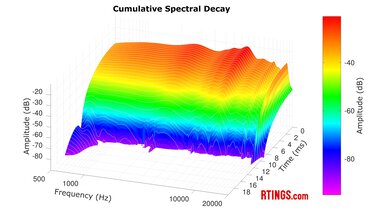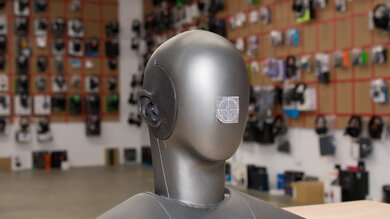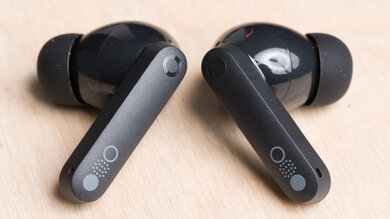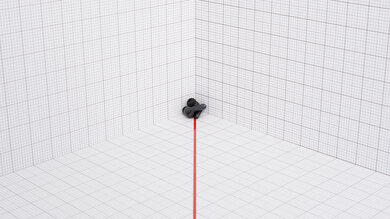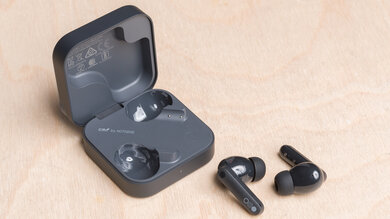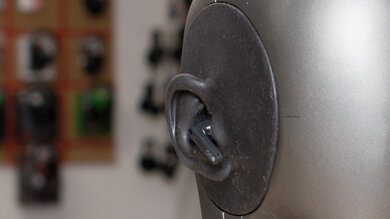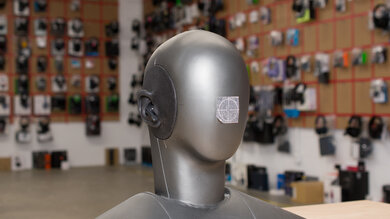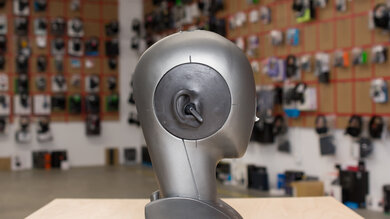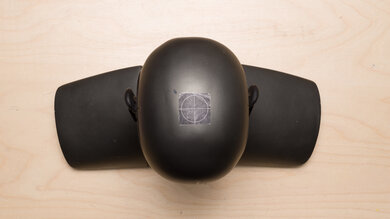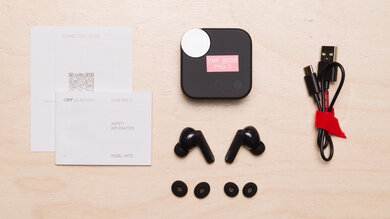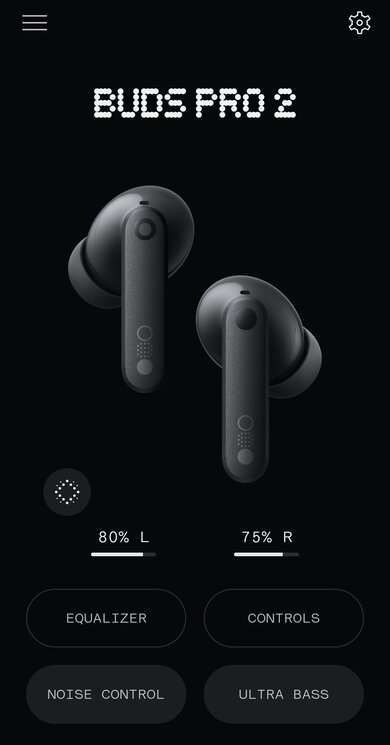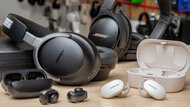The CMF Buds Pro 2 are stemmed Bluetooth earbuds equipped with active noise cancelling (ANC). CMF is an offshoot of the Nothing brand that aims to offer affordable headphones with feature sets that rival those of more expensive wireless in-ears. The Buds Pro 2 use the same app as Nothing earbuds but with slightly different features, so if you're familiar with the quirks of Nothing products, you'll feel at home. These opaque and monochromatic earbuds use touch-sensitive controls with a unique rotating and clickable dial on the case for additional commands.
Our Verdict
The CMF Buds Pro 2 are very good for sports and fitness. They're portable, well-built, and IP-rated against dust and water. Their ample low-end holds down the beat during your workout, and the battery lasts long enough to get through a few trips to the gym. The buds feel comfortable and lightweight, though how well they can stay in-ear depends on the fit you achieve because they lack stabilizers and are a bit chunky. Still, the noise isolation means you can focus at the gym without outside distractions.
-
Low leakage.
-
Very good noise isolation performance.
-
Lightweight and portable.
-
Lacks stabilizers or hooks, so fit depends on your ear shape.
The CMF Buds Pro 2 are good for traveling and commuting. The portable, lightweight design is easy to stow in your bag, and the effective and adjustable noise isolation means you can choose a setting based on how noisy the bus or airplane cabin is. They're decently comfortable, and the control scheme lends itself well to customizing your experience. On the other hand, the continuous battery life is long enough for shorter plane rides, but the buds will need a recharge if you're doing an extended trip.
-
Low leakage.
-
Very good noise isolation performance.
-
Lightweight and portable.
-
Continuous battery life is just okay.
-
Mic sounds passable, but not good.
The CMF Buds Pro 2 are decent for office work. Their ANC is good for cutting out the noise of nearby chit-chat so you can focus on your tasks. Their multi-device pairing also makes it easy to switch between devices. They feel decently comfortable to wear for extended sessions, and they're lightweight, too. However, the battery life isn't long enough to last through an entire workday without a recharge. If you take many calls, the mic is okay for the occasional meeting, but it's not a substitute for a headset microphone.
-
Low leakage.
-
Very good noise isolation performance.
-
Continuous battery life is just okay.
-
Mic sounds passable, but not good.
The CMF Buds Pro 2 aren't suitable for wireless gaming. Despite having a Low Lag mode, the Bluetooth earbuds still exhibit high enough latency that you may experience a mismatch between your game's visuals and the audio.
The CMF Buds Pro 2 wireless earbuds can't be used for wired gaming because they're Bluetooth-only.
The CMF Buds Pro 2 have decent audio reproduction accuracy. They don't deviate much from their bass-heavy default sound, which you can tailor to your preferences using the three-band EQ in their companion app. You can even engage Ultra Bass to inject more low-end into your audio. Their left and right drivers are well-matched, so objects are correctly placed in the stereo field, and low group delay ensures transparent transient reproduction. The lowest 808 kick drum tones can sound just a touch flabby, but it's hard to notice in real-world listening.
The CMF Buds Pro 2 have great noise isolation. They do a good job of attenuating the low-pitched rumbles of airplane engines and consistently block out mid-range sounds like office chatter, too. They're not quite as good in the treble range, so you might hear higher-pitched sounds like A/C whine alongside your audio.
The CMF Buds Pro 2 have an alright mic. They do a decent job of separating out background noise from your voice, but you don't sound especially true-to-life. There's no sidetone, but the dedicated controls make calls easy to control via the buds.
The CMF by Nothing Buds Pro 2 have superb frequency response consistency, delivering consistent audio with every wear.
- 7.9 Sports And Fitness
- 7.7 Travel
- 7.4 Office Work
- 5.4 Wireless Gaming (In Development)
- 5.3 Wired Gaming (In Development)
Performance Usages
- 7.2 Audio Reproduction Accuracy
- 8.2 Noise Isolation
- 6.8 Microphone (In Development)
- 9.0 Frequency Response Consistency
Changelog
-
Updated May 21, 2025:
This review has been updated to Test Bench 2.0, which adds the following tests: Stereo Mismatch, Group Delay, Cumulative Spectral Decay, PRTF, Harmonic Distortion, and Electrical Aspects. We've added new performance usages and updated the text throughout the Sound tests and side-by-sides.
- Updated May 14, 2025: We've converted this review to Test Bench 2.0, which updates our sound tests and adds performance usages. You can read more about this in our changelog.
- Updated Apr 09, 2025: Review published.
- Updated Apr 02, 2025: Early access published.
- Updated Mar 20, 2025: Our testers have started testing this product.
Check Price
Differences Between Sizes And Variants
The CMF Buds Pro 2 come in 'Dark Grey,' 'Light Grey,' 'Orange,' and 'Blue.' Our unit is 'Dark Grey'; you can see their label here. We expect the color variants to perform very similarly to our unit.
If you encounter another variant of these headphones, please let us know in the comments, and we'll update our review.
Popular Headphones Comparisons
The CMF Buds Pro 2 have a lot in common with products like the Nothing Ear and Nothing Ear (a). For starters, the Nothing X app works very similarly for the CMF buds as it does for the Nothing Ear (a), with an equivalent three-band EQ. The Buds Pro 2 differ from the Nothing line by adding Dirac Opteo, a digital signal processor (DSP) that alters the sound, in this case, lending a bassier tuning than the Nothing line's default tuning. While the Nothing Ear have IP ratings for the earbuds and the case, the Buds Pro 2 only have an IP rating for the earbuds; little details like that, alongside touch controls on the CMF, in contrast to pinch controls on the Nothing line, are other points of difference to consider. Still, there are other competitors, such as the OnePlus Buds 3, which trade blows with the Buds Pro 2 when it comes to battery life, noise isolation, Bluetooth connectivity, and controls. Out of the box, the OnePlus are brighter, but that's really a matter of taste and possibly addressed through equalization. It's a crowded market, and the Buds Pro 2's charging case with a dial for additional controls helps them stand out from the barrage of stemmed Bluetooth buds out there.
For more options, check out the best noise cancelling earbuds, the best wireless earbuds under $100, and the best wireless earbuds for Android.
The CMF Buds Pro 2 and the Nothing Ear (a) share many commonalities, including the same companion app and LDAC Bluetooth codec. The CMF are bassier by default and have a slightly longer continuous battery life. The Nothing pinch controls are a bit more predictable to use with fewer misfires, though. Plus, the Nothing are slightly more stable and comfortable fitting. Still, the CMF's ANC is more effective, so your choice depends on priorities and fit preferences. In any case, you can EQ both pairs to sound fairly alike.
The Nothing Ear are more upscale than the CMF Buds Pro 2, though their shared parent company means many features, including the app, are the same. The Nothing boast a more balanced sound signature by default with a more in-depth graphic equalizer for tinkerers. Their battery life is slightly longer, and they're slightly better built, too. On the other hand, the CMF offer a bit more powerful noise isolation overall. Other differences are dependent on taste, such as pinch controls on the Nothing or touch controls on the CMF.
The Nothing Ear (2) belong to a previous generation of earbuds with less powerful ANC than the CMF Buds Pro 2. That said, the Nothing have a more comprehensive equalizer and a flatter sound profile. They're better made and use pinch controls. Still, the CMF use the same app as the Nothing, albeit with a slightly pared-back version with a simpler EQ. They're bassier by default and have a slightly longer continuous battery life. However, their touch controls are a bit less reliable than the Nothing.
The Anker Soundcore Liberty 4 NC Truly Wireless are a bit better than the CMF Buds Pro 2. Although they share similar characteristics like bassy tunings, the Anker are more comfortable and less bulky in-ears with a slightly nicer-feeling plastic finish. Their continuous battery life with ANC on is nine hours compared to 6.5 hours with the CMF. Combined with the case's recharges, the Anker has 45 hours of battery life, while the CMF has a total battery life of only 26 hours. That said, the CMF have a higher IP55 rating than the Anker's lesser IPX4 rating. The CMF also boasts a slightly better mic system than the Anker. Otherwise, these earbuds have more in common than they don't: LDAC codec support, comprehensive graphic EQ (you get more bands on the Anker), multi-device pairing, and ANC that punches above the price tag.
There are good reasons to pick either the Anker Soundcore Space A40 Truly Wireless or the CMF Buds Pro 2. The primary reasons to choose the Anker are for the longer-lasting, continuous battery life and slightly better noise isolation. Meanwhile, the CMF are a bit more refined in design with a more stable fit, dustproofing, and a better microphone. Of course, your tastes will weigh in even with the presence of an EQ, because you might prefer the Anker's flat tuning or the CMF's more bassy sound profile.
The CMF Buds Pro 2 and the Anker Soundcore P40i are both affordable ANC earbuds with different strengths and weaknesses. Both are bassy, but the CMF sound a bit more balanced with a warmer treble, while the Anker have a much more excited sound profile. You can EQ either. The CMF have a more accurate-sounding microphone system that filters out background noise a bit better. They also let you use the LDAC codec for Hi-Res audio files. Meanwhile, the Anker boast a longer continuous battery life and a lower latency performance. The Anker also feel a little more comfortable with more ear tips to find your fit.
The Bose QuietComfort Ultra Headphones Wireless and the CMF Buds Pro 2 serve different purposes and different market price points. The Bose are premium over-ears, designed for people willing to pay top dollar for outstanding ANC. And to that end, they deliver. The Bose block out everything from the low rumble of plane engines to higher-pitched office chatter. On the other hand, the CMF are affordable in-ears that are extremely portable and still offer very good ANC. Their bass-heavy sound isn't as balanced as the Bose, but you can tweak the sound of both pairs in their companion apps.

We've upgraded our Headphones Test Bench to 2.0! This update brings several key changes to our tests and usages, making it easier than ever to interpret our sound results based on your personal preferences. You'll also find a brand-new interactive graph tool featuring multiple targets (including our own!) for you to explore and compare.
For a full breakdown, check out our changelog, which includes detailed commentary from our test designer explaining the rationale behind our update.
We'd also love to hear your thoughts: your feedback helps us keep improving, so join us in the comments!
Test Results
When the Dirac Opteo setting is enabled with ANC on, the CMF Buds Pro 2 have a bassy sound profile. This tuning has more in common with the Anker Soundcore Liberty 4 NC Truly Wireless than the Nothing Ear (a) that the CMF shares their app with.
Through the app, you can access other EQ presets. If you choose to connect via the LDAC codec, it disables the Dirac Opteo setting. In addition to the EQ presets, you can enable the Ultra Bass setting, which does what it says on the tin by upping the bass in the frequency response. While the sound profile mostly adheres to the same curve, there's a bit less bass and treble and a little more mid-range when you disable ANC.
The earbuds' frequency response consistency is fantastic. There's very little deviation in sound between seatings. As long as you take the time to get a good fit, you'll get consistent audio with each wear.
The bass compliance with our target response profile is passable. The entire region is boosted for ample thump and punch, which you might enjoy if you like that extra low-end oomph on sub-bass synths and kicks on songs like No Business by Durand Bernarr and E-Whizz. Still, the added bass can make it harder for vocals and leads in other frequency ranges to come through with clarity.
The mid-range target compliance is great. Although it tilts to emphasize the low-mids and slightly de-emphasize the high-mids, it's mostly balanced, so melodic instruments and speech sound natural.
The treble compliance is fair. The low-treble range is relatively de-emphasized, which warms up vocals but can sound dull. A peak in the mid-treble brightens up sibilants (S and T sounds) and the harmonics of cymbal hits, but it can sound a bit piercing relative to the duller low-treble.
The CMF Buds Pro 2 have great peaks and dips performance. There are small wobbles, which are subtle through the bass and mid-range, producing a smooth sound. The low-treble has a small peak that is a little harsh, followed by a dip that slightly dulls vocals. A peak in the mid-treble causes cymbals to jump out in the mix as somewhat piercing, while the dips and peaks in the upper treble can depend on your hearing sensitivity.
The CMF Buds Pro 2 have well-matched left and right drivers. They're especially well-matched in amplitude, with only minor deviations across the frequency spectrum that are difficult to notice when listening to real-world audio. The phase response is also good. While the phase mismatch skirts the audibility threshold in a couple of places, we didn't notice any issues in practice.
The CMF Buds Pro 2 have good group delay performance. The group delay skirts the audibility threshold in the low-bass, which can make sounds like 808 kick drums feel a touch flabby. However, negligible group delay in the mids and treble ensures well-defined transient reproduction.
These are in-ear fitting buds, and as a result, they bypass your pinnae, which correlate with your perception of direction and distance.
The CMF Buds Pro 2 have remarkably low distortion, even at very high volumes. You'll hear pure and clean audio reproduction regardless of your listening level.
Through the Nothing X app, you can access the spatial audio effect. It's created by DSP, so it applies an effect to your audio regardless of whether it has been mixed and mastered specifically for the spatial audio effect. Functionally, it's a bit sparse and doesn't track your head movements, which would make it feel more immersive like the Apple AirPods Pro (2nd generation)'s Spatialize implementation. Still, it's an interesting way to hear your music differently or experiment with making an action movie seem more engaging.
These are the settings used to test these earbuds. Our results are only valid when using them in this configuration.
The CMF Buds Pro 2 look a lot like other stemmed earbuds that borrow the basic shape from Apple AirPods Pro (2nd generation) lineage. They use a mixture of glossy and matte plastics for added visual interest in an otherwise mostly monochromatic or tonal scheme. The outer edge of the stems is matte with subtle branding, too. Available in 'Dark Grey,' 'Light Grey,' 'Orange,' and 'Blue,' each set comes with a matching squarish case that includes a dial. The solid colors are a visual departure from the translucent retro-futuristic look of the Nothing Ear, produced by the parent company.
The earbuds feel decently comfortable. They're lightweight with three sizes of oblong silicone ear tips. Since they're light and don't fit too deeply in-ear, you won't feel a lot of pressure. That said, the buds are on the larger size and can inch out over time, requiring adjustment. Compared to more ergonomic designs or ones with additional stabilizers, their fit and comfort can vary depending on your ear shape.
The CMF Buds Pro 2 have good controls overall. Out of the box, the touch commands on the buds are intuitive. You can view the default controls for the left bud and right bud. They chime to indicate pairing status or when you enter a command. You can reassign these commands within their app to suit your needs, alongside the extra controls you can map onto the case's rotating and clickable dial. However, the case's controls are disabled by default, and it's possible (if you assign controls to the wheel) to accidentally trigger a command when the case is stowed in your pocket. Still, the option to add extra functions to the wheel is handy.
The touch controls on the buds are also a bit fussy and don't consistently respond, occasionally misfiring the number of taps you enter, though. On the upside, having more than a single tap somewhat mitigates accidentally registering a command.
The charging case is good. Its squarish shape resembles the Nothing Ear's case silhouette with a clamshell opening design that lets it sit on a flat surface without sliding around. It charges via USB-C but not wirelessly. A pairing button resides inside the case and a single LED on the outside indicates pairing and battery charge statuses. The rotating control wheel is the only point of possible weakness and seems a bit flimsier than the rest of the case.
The CMF Buds Pro 2 are well built. The buds and case are made of good-quality plastic and silicone for the ear tips. The buds don't have obvious or rough seams to irritate your ears. There's some conflict on the product page and box as to whether the earbuds are rated IP55 or IP54 for dust and water resistance, but we don't perform compliance tests. In any case, they ought to stand up to raindrops and a bit of dust exposure.
The case's magnets and hinges feel sturdy, while the plastic has a pleasing matte texture. That said, the control wheel on the case feels a bit flimsy and it shifts a bit when clicking or rotating it.
The earbuds have good stability. For everyday activities like walks, office work, and commutes, they stay in when you tilt your head or lightly shake it. However, their in-ear fit isn't very deep, so more vigorous movements can knock them loose since their plastic isn't grippy, and neither are the ear tips.
The CMF Buds Pro 2 have very good noise isolation. With the ANC set to 'High,' they cut out low-pitched noise well, as well as mid-range sounds like office chit-chat. You can also choose 'Adaptive' mode, which seems to perform similarly to 'High,' or choose a lower strength for less environmental isolation, as shown for comparison. While the buds have a fit test in the app to help you find the best ear tip size, the buds don't passively block shrill noises super consistently. That means some high-pitched noises can stick out more than others, depending on the frequency.
The CMF Buds Pro 2 have impressive noise isolation in common scenarios. They attenuate deep noises like street construction, alongside airplane din, and shrill racket such as squeaky brakes well. They perform similarly to the affordable Anker Soundcore Space A40 Truly Wireless, which edge ahead when it comes to office noises.
These don't have a dedicated wind mode to mitigate the noises produced by ANC when wind interacts with the mics. That said, the amount of unwanted noises from the interaction with wind that reach your ears depends on the angle of the wind blowing.
Their leakage performance is excellent. Depending on your environment and how high your volume is set, most people won't hear your audio. But if they do, they'll hear a very thin version of your audio.
The microphone system is passable. It captures your voice intelligibly because it includes most of the range where human voices reside. But it cuts the lows, thinning out your voice a bit, and also boosts frequencies where sibilants occur, which can make your voice sound artificially piercing.
The mic's noise handling is satisfactory. It prioritizes your voice, but because the noise gating is constantly adjusting, intermittent background noise still comes through at times. Sudden sounds like trains are mostly filtered out, so callers can still hear you speaking.
The battery performance is satisfactory. With ANC on, the continuous battery life measured was 6.5 hours, which lines up well with the advertised battery life (when using the AAC codec). It's a little shorter than the more upscale Nothing Ear but longer-lasting than the pared-back Nothing Ear (a). The case provides an extra three charges and recharges the buds fully in under an hour. A quick charge of 10 minutes is advertised to yield 1.8 hours of playback with ANC. Depending on how you use the earbuds, it affects the battery life, so if you take a lot of calls, it reduces the battery life slightly, and the LDAC codec decreases the playback time to only 4.3 hours, according to the manufacturer.
Despite the brand name of CMF, the earbuds use their parent company's Nothing X app, which works with Android and iOS. Its functionality is good—in use, it's very similar to the Nothing Ear (a) with EQ presets and a three-band EQ, while lacking the more comprehensive graphic EQ with Q-factor supported on the Nothing Ear. If you want even more bass, you can choose Ultra Bass to augment any of the EQ presets. Take a look at the tour of the app.
It includes a fit test, alongside letting you remap the controls to your tastes and allocate commands to the charging case's wheel. You can adjust the strength of ANC or enable Transparency mode. Low-lag mode and LDAC codecs are available connection options, too, though using LDAC disables the Dirac Opteo sound mode. Control over multi-pair with two devices, and Find My Earbuds help you manage the buds. In lieu of a traditional voice assistant, you can integrate ChatGPT, which is more streamlined if you also get the CMF Phone 1 to match. However, unlike Apple, most of the functions are available outside of the CMF/Nothing ecosystem.
The CMF Buds Pro 2 have excellent Bluetooth connectivity. They can connect over AAC, LDAC, or the standard SBC codecs. You can enable Dual Connection via the app to pair a second device, though it's not a seamless connection, and you need to manually switch devices through the app. The app has a Low Lag mode, which was enabled for the measurements shown, so depending on your device and app, you may still experience A/V mismatch with videos. They support Google Fast Pair and Microsoft Swift Pair with compatible devices, but don't quick pair to iOS.
You can connect the earbuds to Bluetooth-compatible PCs for full mic and audio support.
Comments
CMF Buds Pro 2: Main Discussion
Let us know why you want us to review the product here, or encourage others to vote for this product.
- 21010
bought these and tried them. the anc boosting treble noises is unbearable for me. things like circada, metal clings between train wheel and the rails, and ac air cutting thru grills were getting boosted to a point that it was giving me tinnitus.
should’ve listened to whoever wrote that anc section.
- 21010
do you measure max spl value with spatial sound on or off? with spacial sound these become little louder than normal mode
Hey ashkank,
We measured the SPL at Max Volume with Spatial Audio Off. Our published results, including measurements and graphs are taken with any Virtual Soundstage disabled to keep things on a closer playing field between different products. For the moment, our Virtual Soundstage testing is limited compatibility tests and subjective impressions.
Thanks, Matt
- 21010
do you measure max spl value with spatial sound on or off? with spacial sound these become little louder than normal mode
Update: This review has been updated to Test Bench 2.0, which adds the following tests: Stereo Mismatch, Group Delay, Cumulative Spectral Decay, PRTF, Harmonic Distortion, and Electrical Aspects. We’ve added new performance usages and updated the text throughout the Sound tests and side-by-sides.
- 21010
Thanks for your testing. Is cmf buds 2 pro have higher bass than anker soundcore p40i at max volume? cmf buds 2 pro ultrabass works well in lower volume but when you reach near max volume ultrabass no longer works. Is anker p40i have same Behavior for bass boost preset equalizer? Because in your frequency response graph p40i have 15db emphasis on bass boost mode but cmf ultrabass is 10db emphasis so is it mean cmf buds 2 pro have weaker bass compare to anker p40i? every review I watch said cmf buds 2 pro is bassiest and loudest buds under 100 bucks but your FR charts show otherwise. So which one is better for bass heads and retain powerful bass till max volume? And other question is p40i gaming mode retain sound quality like normal mode?
Hey, We don’t typically measure headphones at max volume for a few reasons. Max volume isn’t the same loudness between different pairs of headphones, so it’s not a comparable metric (except to explain how loud the headphones can get under our testing conditions). Most people don’t listen at max volume either because it’s not healthy for prolonged periods. So, if I understand part of your question correctly, are you asking if the Ultra Bass setting is less bassy as you increase volume? As far as I know, the Ultra Bass frequency response doesn’t change with volume, but our brains perceive audio frequencies differently depending on the loudness (this is how equal loudness contour works), and it’s the basis for adaptive EQ on headphones that have it. I don’t think Ultra Bass is an adaptive EQ, though.
As for whether the Anker Soundcore P40i are bassier than the CMF Buds Pro 2, the answer depends on your preferences to a degree and how sensitive your ears are to treble. The Ankers have a much more excited V-shaped frequency response, so while there’s a boosted bass, there’s also a brighter and sharper treble, which some people like, while other people perceive that as distractingly sharp. The CMF have a de-emphasized treble response alongside boosted bass, which means vocal and cymbal harmonics tend to sound warmer/duller, and this can make the bass seem deeper. For these reasons, I suggest you consider the raw frequency responses as a whole and keep in mind that the way our brains process audio is that the loudest sounds cut through the most, but it’s about balancing scales. I’d think the CMF are probably what you’re looking for, but then again, you can use EQ with either and expect to find very bassy settings.
The Anker only uses the SBC and AAC codecs, which transmit audio at a lower fidelity than LDAC, which the CMF can use, but your device needs to be able to support LDAC to take advantage of the higher resolution. So if you use an Apple phone, for example, both pairs of earbuds have basically the same audio compression. We didn’t notice a difference with ‘Game’ mode on the Anker’s audio quality. Hope that helps.


